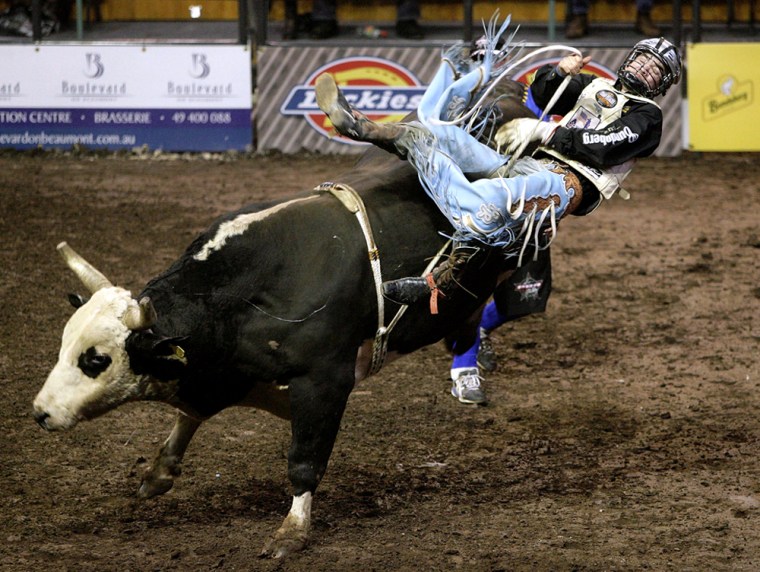When Professional Bull Riders Inc. named Randy Bernard its chief executive officer in 1995, the 28-year-old was proud to tell people he worked for PBR. But their response was less than heartening.
“They’d say, ‘Pabst Blue Ribbon?’ ” recalled Bernard.
Few sports fans would make that mistake today. The growth of PBR – the bull riding league founded in 1992, not the beer – has thrust it into the public consciousness, even if it’s not yet center stage among pro sports.
Consider this: During the year of its launch, a little more than 300,000 fans attended PBR events across the nation. Today, that number has more than quintupled. The typical fan (an 18-to-34-year-old), who pays $38.40 per ticket on average, is appealing to advertisers.
Big cities have hopped on. This January, for the second year in a row, PBR held an event in the nation’s media capital at Madison Square Garden in the heart of New York. Tickets sold for up to $195 for each event, and Bernard said around 30,000 fans watched the three performances.
In 1995, sponsorship revenue for PBR totaled $365,000. That has exploded – thanks to Wrangler, U.S. Air Force and others – to close to $26 million in 2008. And where the association once lacked coverage in newspaper sports pages because it was considered entertainment, now broadsheets in Dallas and Fort Worth not only report results, but they’ve hired beat writers to follow the sport.
Television is another area where the difference between the early days and today is as large as a bucking bull (average PBR weight; 1,800 pounds). In 2001, the association struck a deal to make its national debut on NBC during a 4 to 6 p.m. time slot the Sunday after Thanksgiving.
”People told me it was the dumbest move I’d ever made,” said Bernard, who competed against golf’s Skins Game, the NFL and figure skating that day.
NBC told him if the event earned a 1.0 rating, PBR would be back on the network. That Monday morning, Bernard was a nervous wreck – until he found out PBR had grabbed a 2.3 rating.
Fast-forward seven years. The sport is shown not just on NBC, but on Versus and Fox, too. This fall, rather than competing against the NFL as it did in 2001, three PBR events will be promoted during Fox NFL broadcasts. Last week, PBR inked its first deal with ESPN to unveil the PBR Team Shootout, a new two-man team competition which will start in August.
Internationally, PBR earns more than $600,000 in rights fees, and the association broadcasts into 85 countries – six years ago, those numbers were, respectively, zero and zero.
By 2007, the payoff arrived for those who had believed in PBR from the outset. The majority of the original 20 bull riders who had invested $1,000 in PBR in 1992 were bought out for millions of dollars by Spire Capital Partners, which now owns a large stake in PBR, along with nearly four dozen cowboys and management.
PBR has attracted celebrity investors recently, such as John Elway and Wayne Gretzky, but they aren’t front-and-center in any advertising campaigns. Former Los Angeles Dodgers manager Tommy Lasorda just joined the fun by investing in a bull called Déjà Blue, who should make its debut this summer.
Lasorda, who first came into contact with PBR a few years back when Bernard asked him to speak to bull riders in Las Vegas, is as enthusiastic about Déjà Blue as he is about Dodger Blue.
”When you own something, you really get attached,” Lasorda said. “Who ever thought about me being involved in bulls? Now, my little granddaughter (12) even knows all the bulls’ names.”
Déjà Blue may end up as part of a recent PBR push: to make the bulls superstars. A survey found that male fans were attracted to PBR for the danger or the matchups, depending on their age. But for women of all ages, the bull was always the draw.
In response, PBR decided to humanize the bulls. An example: Before an event, PBR let Little Yellow Jacket stay in The Broadmoor, a five-star hotel in Colorado, while two-time world champion Chris Shivers was housed at the Doubletree.
”Little Yellow Jacket was treated better than the cowboy,” said Bernard, who noted sales of bull merchandise – T-shirts, caps and the like – has skyrocketed in response to the bull marketing campaign.
What’s the draw of PBR for the sports fan who has been raised on basketball and baseball? There’s potential for peril at events, where a rider must try to stay on the bull for eight seconds (holding on with one hand) without being tossed. Entertainment is part of the package – rock music is blaring and lasers are flashing.
And bull riding is remarkably like mainstream sports in some ways. There’s steroid testing – for bulls, not athletes. There’s a draft, where cowboys get to choose which bull to ride.
In fact, Bernard’s goal is to become a mainstream sport. “We need a great movie to take it mainstream,” he said. Though the title “Raging Bull” has already been used, whatever a professional bull riding film is called, no one will think it’s about beer.
